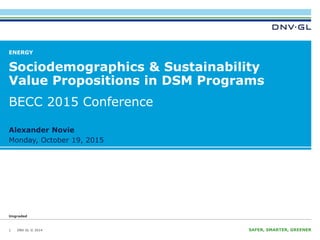Sociodemographics & Sustainability Value Propositions in DSM Programs
- 1. DNV GL ┬® 2014 SAFER, SMARTER, GREENERDNV GL ┬® 2014 SAFER, SMARTER, GREENERDNV GL ┬® 2014 Ungraded Monday, October 19, 2015 Alexander Novie ENERGY Sociodemographics & Sustainability Value Propositions in DSM Programs 1 BECC 2015 Conference
- 2. DNV GL ┬® 2014 Outline Equity in mature EE/DSM programs ŌĆó Articulating sustainability value propositions to diverse audiences Sociodemographic approach ŌĆó Increasing diversity and identifying opportunities New policy levers in CPP/CEIP ŌĆó Using EE/DSM as a resource for ŌĆ£vulnerableŌĆØ communities 2
- 3. DNV GL ┬® 2014 Theoretical frameworks & background Social and behavioral aspects of energy use ŌĆóŌĆ£Where and who are the people in energy policies?ŌĆØ vs. PTEM ŌĆóUse and behavior patterns based on socioeconomic, lifestyle, race/ethnicity and gender Analyzing demographics in EE/DSM ŌĆóParticipation equity ŌĆóApplying residential segmentation to commercial energy users Looking at unique needs of vulnerable groups ŌĆóLocal market nuances used to define ŌĆ£hard-to-reachŌĆØ populations ŌĆóValue propositions & EE as economic development tool 3
- 4. DNV GL ┬® 2014 DSM program participation: equity & engagement DSM programs are maturing ŌĆó Most of the low-hanging fruit has been eaten Utilities are shifting their focus ŌĆó ŌĆ£Meeting goalŌĆØ ’āĀ broader strategies of customer engagement and satisfaction ŌĆó Using EE/DSM as economic development tool A nuanced view of equity is key ŌĆó Sociodemographic overlays can provide additional insight to the traditional focus on customer load, size and market verticals 4
- 5. DNV GL ┬® 2014 Sociodemographics: what factors? Culture, ethnicity and race ŌĆó Different notions of trust with energy providers and installation contractors Language matters ŌĆó Non-English speaking households are much less likely to be aware of potential energy- saving appliances (Murray & Mills 2011) Urbanity matters ŌĆó Rural facilities often have different consumption profiles; reach of contractor network and campaigns 5
- 6. DNV GL ┬® 2014 Changing sociodemographics: increasing diversity 6 Source: Pew Research Center (2015)
- 7. DNV GL ┬® 2014 Total population & Hispanic/Latino 7 25% 35% 13% 10% 10% 46% 82% 25% 28% 43% 0% 10% 20% 30% 40% 50% 60% 70% 80% 90% AZ NV NM CA All US Percent Population Increase from 2000 - 2010: Total & Hispanic or Latino Total Population Hispanic/Latino Population
- 8. DNV GL ┬® 2014 Foreign-born persons since 1980 8 0 5 10 15 20 25 30 NM AZ NV CA US NM AZ NV CA US NM AZ NV CA US NM AZ NV CA US 1980 1990 2000 2010 %ofPopulationthatisForeign-Born Growth in Foreign-Born Populations in NM, AZ, NV, & CA: 1980-2010
- 9. DNV GL ┬® 2014 Public opinion: views on the climate problem 9 Source: Pew Research Center (2015) 70 56 44 50 19 26 22 23 11 17 31 25 Hispanic/Latino African American White U.S. Adults Because of human activity Because of natural patterns There is no solid evidence
- 10. DNV GL ┬® 2014 Public opinion: support for climate initiatives 10 Source: PPIC (2015) 76% 75% 71% 65% African American Latinos Asians Whites Support for GHG reduction in California (SB-32)
- 11. DNV GL ┬® 2014 Other ŌĆ£hard-to-reachŌĆØ in SW Low- income Minority- owned firms Older adults 11
- 12. DNV GL ┬® 2014 Tucson area: kWh savings & per-capita income 12
- 13. DNV GL ┬® 2014 Identifying opportunity: small businesses in Southern Arizona 13 Small Businesses & Program Potential in Santa Cruz County, Arizona Zip Code Total C&I Businesses Businesses with 1 to 4 Employees Businesses with 5 to 9 Employees Ratio of Businesses <10 Employees Projects Completed ITD Potential Market Remaining 85621 725 381 166 75% 73 86% 85646 74 51 12 85% 5 92% 85648 197 104 34 70% 16 88% Santa Cruz Summary 996 536 212 77% 134 87%
- 14. DNV GL ┬® 2014 Takeaways for DSM programs Understanding the communities within the marketplaces ŌĆó Defining ŌĆ£hard-to-reachŌĆØ groups to focus on equity & engagement Analyzing data- driven marketing and outreach ŌĆó Digging deeper into data analytics and looking at the ŌĆ£whoŌĆØ and ŌĆ£whyŌĆØ behind the models 14 Question and refine how sustainability value propositions are communicated
- 15. DNV GL ┬® 2014 Broader implications: CPP & CEIP Clean Power Plan (CPP) framed in environmental justice language ŌĆó Resources for ŌĆ£vulnerableŌĆØ and ŌĆ£overburdenedŌĆØ communities Clean Energy Investment Program (CEIP) ŌĆó 2-1 ERCs for EE projects in low-income and communities of color 15 2-1 in 2020
- 16. DNV GL ┬® 2014 Areas of future research How do we define low-income and communities of color for program design? Rethinking program eligibility? ŌĆó Low-income individuals are already overburdened by paperwork! 16
- 17. DNV GL ┬® 201417 Remember the people behind the data
- 18. DNV GL ┬® 2014 SAFER, SMARTER, GREENER www.dnvgl.com SAFER, SMARTER, GREENER www.dnvgl.com Thank you! alexander.novie@dnvgl.com 18


















